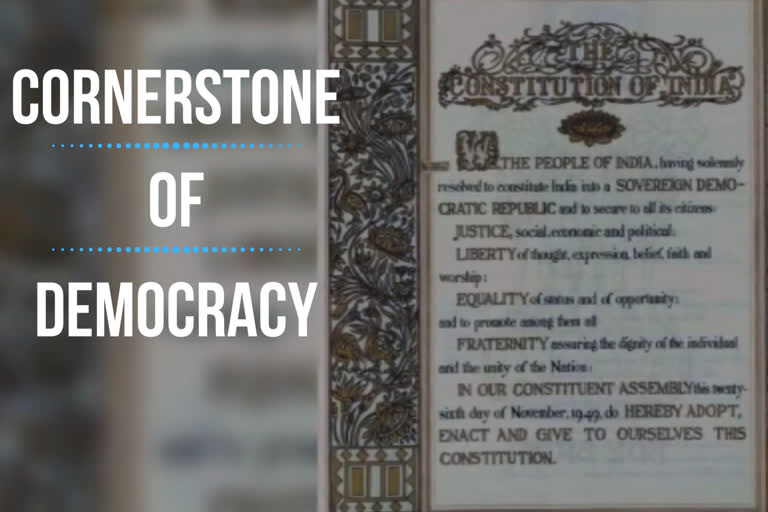Hyderabad: It is believed that when compared to other living beings on the earth, human beings behave more rationally, and live harmoniously without harming other beings as far as possible. But the dwindling resources of the modern age, the growing population, and their needs have made man more selfish, resulting in clashes and vandalism.
In order to curb this kind of anarchy, and balance the ever-growing social complexities, a compendium of rules and regulations has become essential - and that is called the Constitution.
The modern man is not only a social organism but also a political being. Living as a society in a certain area, he designed a system to regulate life - and that is called the State.
The State formed a system of government. The constitutional, executive, judicial system, powers, functions, citizens' rights and responsibilities of the democratic governments are all enshrined in the Constitution. It is the highest ordinance in the country. The Constitution regulates the relationship between the ruler and the ruled.
The Constitution is like a skeletal framework of the State. In a democratic setup, peoples' participation in the government and the accountability of the peoples' representatives, bureaucracy and judiciary to the public is very crucial. The Constitution creates stability for these important functions. Constitutional integrity is the cornerstone of democracy.
Read: Constitutional Amendments that changed the course of the country
KEY OBJECTIVES:
In a democracy, the citizens are rulers and the ruled. In that case, is a Constitution needed to regulate the government? 'Yes', is the answer. The Constitution is the right tool to fulfill the following five key objectives:
- Limiting governmental powers.
- Protecting the common man from abuse of power.
- To tolerate and regulate unpredictable changes in the current and future generations.
- Empowering the depressed classes in the society.
- Elimination of insidious inequalities and the establishment of equal society.
Read: Story behind India's first Interim President of Constituent Assembly
Certain safeguards are embedded in the Constitution to achieve these goals. They are:
Protection with due rights
Constitution of India protects the fundamental rights and civil liberty, and restricts the governmental authority. Directive Principles dictate the State to achieve social and economic justice. The right to freedom of religion enshrined in the Constitution ensures a sense of security to the religious minorities. Secularism forbids governmental interference in religious and cultural matters. Article 17 of the Constitution prohibits the age-old practice of untouchability. In addition to assurances like this, another key aspect is the establishment of an independent judicial system for the country.
Semi-Federalism
Even though the US Constitution influenced the Constitution of India, our constitutional makers have favoured a semi-federalist system. The secession of the Indian subcontinent on religious grounds and the separatist tendency of the people of the northeastern sector, prompted a distinctive constitutional arrangement. The semi-federal government system is comprised of a strong government at the centre and various state governments working with the cooperation of the Central Government in a federal setting.
The Parliamentary government
Our Constitutional Makers, have carefully examined the suitability of Presidential and Parliamentary systems and have chosen the Parliamentary form of government for the people of India. By providing an appropriate place in governance and responsibilities for different parts and sections of the country, this avoids the centralization of power arising in the Presidential System. A parliamentary-style government is a solution to the replacement of the limited-time totalitarian system with the establishment of governments that adapt to changing political conditions and, if necessary, paves way for their removal.
Are the aspirations fulfilled?
Has our constitution worked in the past 70 years to meet the aspirations of the average citizen? The answer is: Yes and No. Many countries that gained independence after World War II have turned from democracy to totalitarianism. Countries like Yugoslavia, the Soviet Union and Sudan have broken up. The main reasons for India's successful continuance as a democratic country and its territorial integrity are the checks and balances embedded in our Constitution. Our country has created a place for itself in the comity of nations, but it must be painfully agreed that the life of common man is not still comfortable.
Dwindling moral values by the day, increasing narrowness, regional, linguistic and communal differences, criminal politics; all these, and tendencies like the opportunism of the political parties raise the suspicion whether is this the same country that Gandhiji dreamt of! We are all responsible for this -- individually and collectively. All sections are failing in fulfilling their responsibilities. They are pointing to the Constitution to cover up their failures. We all have a responsibility to maintain the national integrity, equality and progress.
Read: Indian Constitution, a result of herculean efforts and thoughtful conflicts



